Nevada Twilight
January – February 2020
Local Lore & Mysterious Matters
Episode 1: Misplaced mine bodies, the Garden of Eden, and the Nevada Triangle.
BY ERIC CACHINERO

“You unlock this door with the key of imagination. Beyond it is another dimension; a dimension of sound, a dimension of sight, a dimension of mind. You’re moving into a land of both shadow and substance, of things and ideas. You’ve just crossed over into the Twilight Zone.” -Narrator Rod Serling, “The Twilight Zone”
Mankind’s natural curiosity for the mysterious and unexplained spans our entire history. Where is the lost city of Atlantis? Will we ever know the identity of Jack the Ripper? How were ancient sites like Stonehenge and the Great Pyramids constructed? Is Bigfoot real? What actually caused the dinosaurs to go extinct? Do aliens exist?
Nevada holds its own collection of myths and mysteries, peculiar and unexplained. Some are morbid, some are silly, but all require the reader to take a small step—or leap, if you like—into a “Twilight Zone” mindset. Sit back, relax, and enjoy, because you’ve just crossed over.
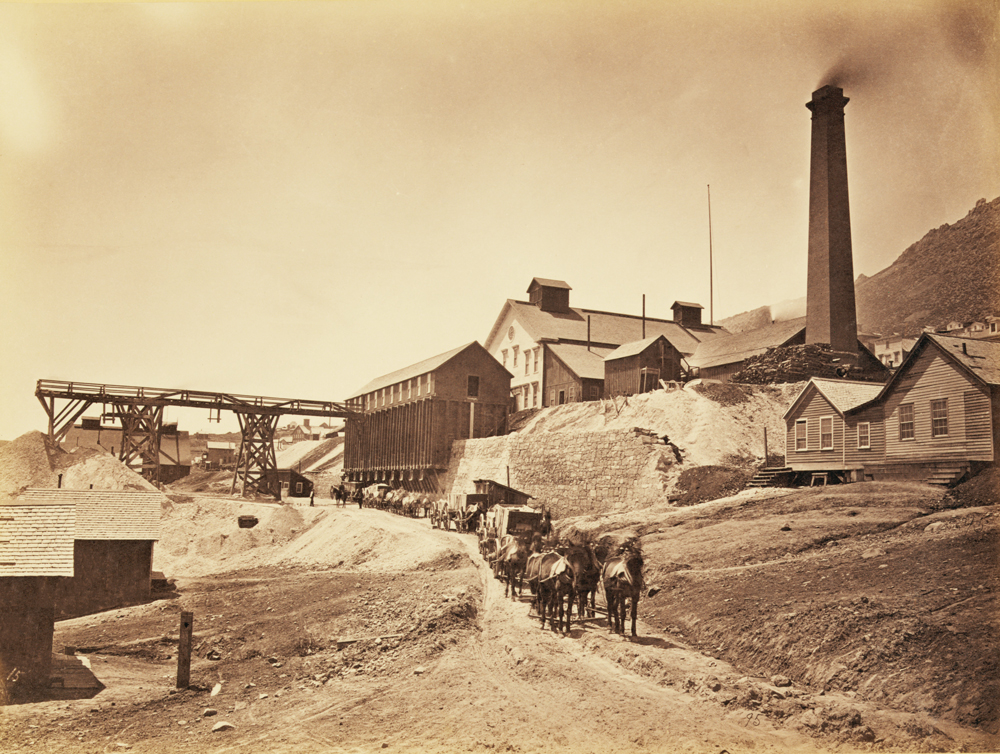
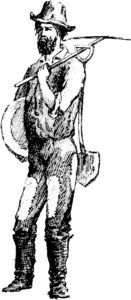
MISPLACED MINE BODIES
In the late 1860s, workers at the Savage Mine in Virginia City ended their shifts. As the men ascended from the deep mineshafts, they had a story of horror to relay. Mine workers had discovered the body of a man in the sump—a drainage hole that routed boiling water out of the mines. The body was badly decomposed and deformed—cooked from the scalding water—and was found with the tattered remnants of a fancy coat and upscale boots. The remains were removed and taken to the morgue, though strangely, no one was reported missing. The tally sheets of the Savage Mine were surveyed by the miners’ union, and everyone was accounted for.
So where did the man come from, and how did he end up thousands of feet below ground? Was it murder?
Several years earlier, in a seemingly unrelated event, San Francisco stock speculator William Meeker was vacationing and boating near Carnelian Bay at Lake Tahoe, when he discovered a small whirlpool on the surface of the lake. Intrigued, Meeker fashioned a makeshift fishing rod, added a length of line, tied a stone on the end, and dropped the stone into the whirlpool. After about 100 feet of line had gone out, something began tugging furiously on the end, and the line began flying off the rod with such violence that it snapped.
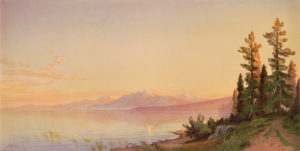
Meeker deduced that the water was escaping the bottom of the lake somehow, but he wasn’t sure exactly where it was flowing to. He recruited the help of fellow speculator Colonel Clair, who was described as “one of the heaviest and most unscrupulous operators in the market and a member of the biggest firms on the street.” The duo hit the books, examining underground waterways of the region, and eventually discovered that the waters of Lake Tahoe were the source of the flooded mines of Virginia City, located some 20 miles away.
Being the investors that they were, Meeker and Clair formulated a plan to cap the lake’s water flow, and also profit from the venture. The plan was to lower a large plug into the hole, with a giant chain attached to the end so they could control the flow. The two aimed first to completely cut the water flow, but not before they invested heavily in the Savage Mine. Shutting off the water would allow them to rake in millions as the drained Savage Mine revealed rich ore deposits, and turning it back on again by removing the plug would allow them to short the market and flood the mines once more, again profiting majorly.
The plan worked.
Meeker and Clair bought long and short positions in the market as they pleased, using the plug to allow water to flow in and out of the Savage Mine.
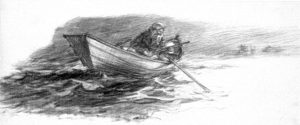
One night as Meeker was on the lake pulling on the chain and removing the plug, a boat ominously approached him, and he feared his unscrupulous venture had been discovered. Meeker’s panic turned to relief, though, as it was Clair that had found him and come aboard.
“I have your share deposited in the Nevada Bank,” Clair told Meeker, “and it is now over 2 million.”
A smile came over Meeker’s face as he continued to pull the plug out.
“How big the moon looks over yonder,” Clair added.
Thwack!
As Meeker turned his head to look, Clair took a heavy iron bar to the back of Meeker’s skull. Clair tied a weight to the body, threw it overboard, and let it sink. Before leaving, Clair lowered the plug into place once more.
Though this story was dreamt up by Nevada newspaperman Samuel Post Davis in his famous fictitious 1901 piece titled “The Mystery of the Savage Sump,” tales of underground water tunnels connecting Lake Tahoe with surrounding areas have been around for years. Rumors abound of similar underground tunnels connecting Lake Tahoe and Pyramid Lake.
Is Davis’ account of the sump body partially rooted in truth? Do people that go missing in Lake Tahoe end up deep beneath The Comstock or on the bottom of Pyramid Lake?
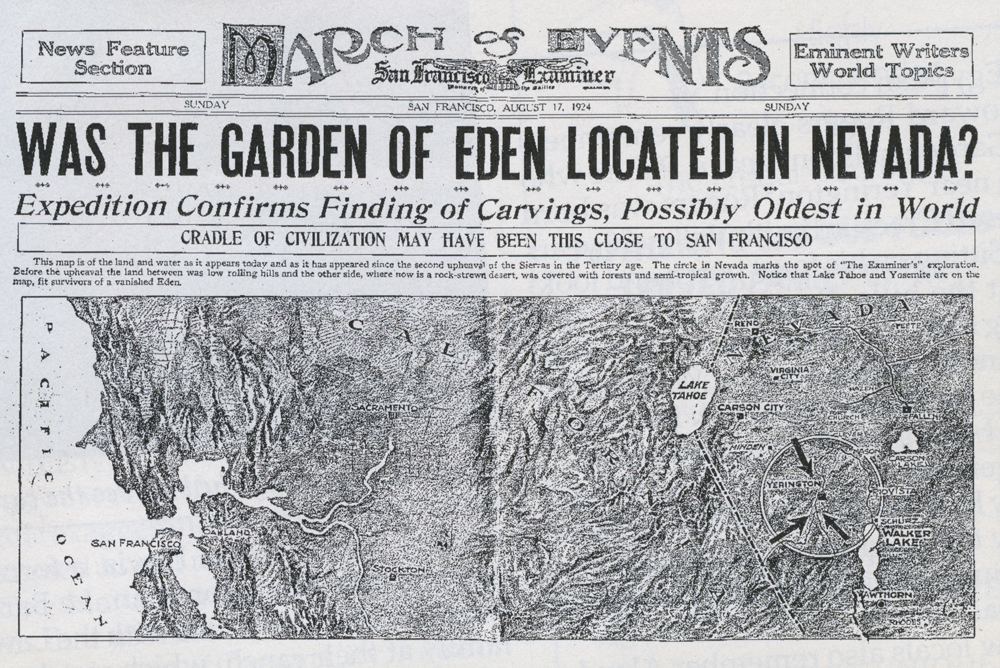
ADAM AND EVE’S PLACE
“WAS THE GARDEN OF EDEN LOCATED IN NEVADA?”
That fervid headline in the Aug. 17, 1924 issue of the “San Francisco Examiner” certainly jumped off the page, though the words that followed would be treated with the same intensity.
“We have found what appears to be the evidence of the oldest civilization in the world—the oldest writing, the oldest art, the oldest sacrifice, the oldest worship, the oldest burial.”
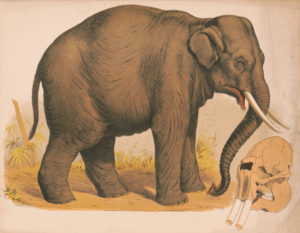
The words could be attributed to the “Examiner’s” Sunday editor Edward Clark, though they were set in motion by geologist and engineer captain Alan Le Baron, who had made the greatest archeological discovery the world had ever seen. In 1923, Le Baron—who had lived in Egypt and spent time in Mesopotamia—stumbled upon a special plot of land along the Walker River that contained a wealth of historical artifacts, writings, and remains. Le Baron had discovered bones of prehistoric camels, lions, and elephants interspersed with petrified remains of ancient forests. Most interesting about Le Baron’s discovery, though, was that he believed the thousands of petroglyphs in the site were Egyptian and Babylonian in origin.
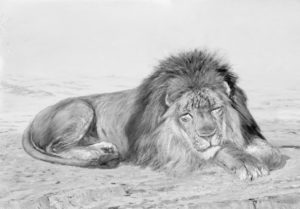
“The writings have been checked by every method of my command and I am prepared to say positively that this is not the work of Indians,” he explained.
Through a series of sensational articles published in the “Examiner,” Le Baron would continue to tell of his new discoveries. These were even backed by Stanford Professor Dr. H. R. Fairclough, who later wrote, “I should not be at all surprised if ultimately it will be found that the earliest human life in America was in some such region as that of Nevada,” and University College of London professor Eliot Smith, who added this of Le Baron’s discoveries: “No such monument has ever before been reported in this continent…nothing like it has ever be found; it is isolated in a region where none but Indians were known to have lived.”
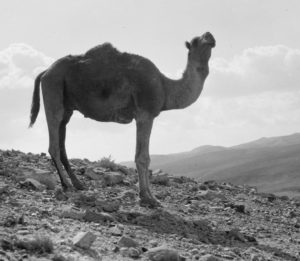
In a follow-up article in the “Examiner” published Aug. 19, Le Baron prefaced a lengthy penning with the words, “Paradise regained!” He wrote of the discovery of what he would call the Hill of a Thousand Tombs—a burial site so old, that bones had turned to a chalky blue-yellow dust that was buried among the stones. It is here that he claimed Adam and Eve themselves had sojourned. He surmised that because of the massive quantity of sun symbols on the rocks, the area must be a “place of worship.” Le Baron led several archaeological excavations of the site, though they had to be abandoned because of water flowing into holes once they were dug. Nonetheless, he claimed that rocks at the site were carefully placed to seal rock tombs, even writing that “you could roll that stone away like the one that was rolled from the tomb of Christ.”
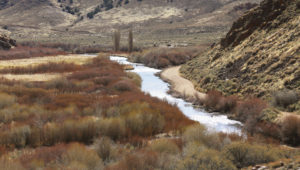
Le Baron’s claims—along with those of a litany of prestigious scholars—wouldn’t soon fade from the spotlight. His works would go on to be published in several books and magazines, including “Theosophy” magazine in 1925, and historical geographer Richard V. Francaviglia’s book “Believing in Place: Spiritual Geography of the Great Basin.”
His research and articles led to semi-stardom in Yerington for a time, though strangely, his presence didn’t last long. It’s like he almost vanished into thin air.
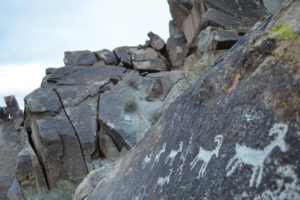
In the July-August 1993 issue of Nevada Magazine author Harry A. Chalekian wrote that Le Baron, “was last seen working with a road crew on a highway project between Fernley and Yerington.”
Once Le Baron faded from the public eye, the fallacies and misrepresentations of his works gathered momentum like an out-of-control snowball. Experts examined the petroglyphs Le Baron had claimed were Egyptian or Babylonian and concluded that they were definitely American Indian in nature and were no older than several thousand years. Additionally, it was discovered that the ancient “bone dust” at the Hill of a Thousand Tombs belonged to native fauna.
So why did the world believe Le Baron for so long? How did so many profound scientists agree with his works, only to have them seemingly easily dismissed years later? And what really happened to Le Baron?
THE NEVADA TRIANGLE
At around 8:45 a.m. on Sept. 3, 2007, pilot, sailor, and adventurer Steve Fossett departed from the Flying-M Ranch in Smith Valley in his single-engine Super Decathlon.
He never returned.
After his disappearance, search and rescue teams hunted for a month, but were unable to locate Fossett or the plane. There was no SOS signal emitted from the plane’s emergency locator transmitter. Eventually, the search was called off.
Then on Sept. 29, 2008, a hiker discovered Fossett’s identification cards high in the Sierra Nevada range in California. Several days later, the crash site was identified, some 65 miles away from the Flying-M Ranch. In addition, bones were found a half mile from the crash site, and were confirmed to be Fossett’s.
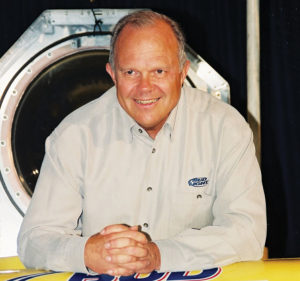
Fossett’s mysterious disappearance is part of a much larger trend of plane disappearances reported in what has become known as the Nevada Triangle—an area defined as a triangle spanning from Reno at the top; to Fresno, California at the bottom; and Las Vegas at the east. The Smithsonian Channel, KRNV Channel 4 Reno, and Nevada Public Radio claim more than 2,000 planes have gone missing in the area during the last 60 years, with many of the crash sites never found.
One of the first planes to go missing in the area was a B-24 bomber. On Dec. 5, 1943, the plane—piloted by 2nd Lieutenant Willis Turvey and co-piloted by 2nd Lieutenant Robert M. Hester, along with four other crew members—departed Fresno, California on a routine training mission. It would disappear completely. The following day, nine B-24 bombers were sent to search for the missing plane. Tragically, one of those nine also went missing during the search.

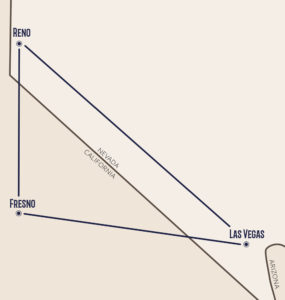 The second missing plane was found to have crashed into Huntington Lake reservoir, though it wasn’t recovered until 1955 when repairs to the reservoir’s dam required the water to be drained. The plane was found resting 190 feet below the surface, with five crewmembers still at their stations. The first missing B-24 wreckage wasn’t discovered until 1960, and was found in and around a remote unnamed lake high in the Sierra.
The second missing plane was found to have crashed into Huntington Lake reservoir, though it wasn’t recovered until 1955 when repairs to the reservoir’s dam required the water to be drained. The plane was found resting 190 feet below the surface, with five crewmembers still at their stations. The first missing B-24 wreckage wasn’t discovered until 1960, and was found in and around a remote unnamed lake high in the Sierra.
A multitude of theories exist as to what has caused such an anomalous series of wrecks and disappearances in this Nevada Triangle. One of the most-accepted chalks it up to wind downdrafts—downward air currents that have the potential to reach several hundred miles per hour—though ominous theories also abound. Because of the triangle’s proximity to the renowned Area 51—a “secret” and highly-classified Air Force base located deep in the Nevada desert—people have theorized that missing pilots may have seen something they weren’t supposed to see.
What really caused more than 2,000 planes to crash or go missing in the Nevada Triangle? Will we ever know the true cause of the missing planes? And does Area 51 have anything to do with it?


 Read More About It
Read More About It